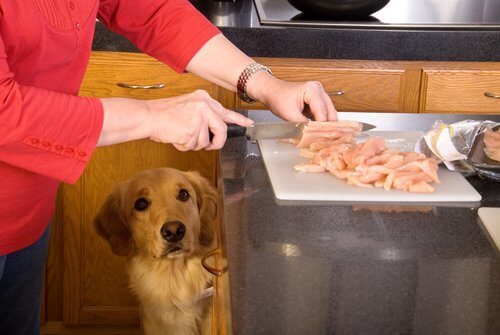Three Steps to Treat Burns on Pets

Burns on pets look just like a burn on your own skin. Unfortunately, the animal’s hair often covers it and so it may be more difficult to recognize it unless we’re there when it happens.
What are the most frequent causes of burns on pets?
The most frequent causes of burns on pets are:
- Spilling of boiling water and oil
- Burns on their leg pads caused by the extreme heat of the ground
- Something hot that spilled on the floor
- Excessive exposure to the heat or sun
In exceptional cases, if your pet has had surgery and the wound is still in the process of healing, exposure to the sun could cause a burn. How can we respond and act in any of these cases?

Right after a burn: lower the temperature
There is a myth that ice is the most advisable thing to lower the temperature of a burnt area; the truth is that this will make it worse.
The low temperature of the ice also causes burns on the skin, and so applying it directly to burned dermis will worsen, rather than improve, the situation. So, the most advisable way to reduce the skin temperature on a burnt area is to do so with cold water –it also aids in cleansing the wound.
After doing this, it’s advisable to apply an ointment for burns (you should always keep some in your first aid kit at home), as this will prevent infections and relieve pain.
Clean the area
It’s recommended that once the pain and heat have been relieved with the water and the ointment, the hair surrounding the affected area should be trimmed very carefully. If not, then it will cause discomfort and can even transport bacteria or parasites that the animal may be carrying.
Another reason for this is that the hair around a burnt area will hinder the next step: to cover the wound. This is done in order to prevent the wound from getting dirty and to prevent infections. However, if the veterinarian instructs you to, then you should clean the wound every day and apply ointment afterward.
Normally, a burn will be healed in 12 to 15 days.
Take your pet to a veterinarian
A burn on our pets can be a lot more painful than a burn on humans. This is because their skin has endless nerve endings that are very sensitive to any damage.
Therefore, if you don’t dare to touch the area, or if your pet cries excessively when you touch him, go to the vet, as there they can sedate her before cleaning and healing the wound so that the animal doesn’t suffer more than it needs to.
In case of a serious burn, a veterinarian can perform surgery in order to remove the burnt skin and graft new skin.

How to prevent burns on pets
We know that your pet loves you and wants to be around you constantly, and of course, you love it! Even so, you’ll have to bite the bullet and forbid access to certain areas of the house at certain times. For example:
- The kitchen. Don’t allow your pet to be around you while you cook. These accidents can happen at any time.
- The beach. Even if it’s a dog beach, don’t let your dog put its delicate pads on the sand. When the heat from the sun is at its highest it could cause burns.
- Terrace. Don’t leave your pet on the terrace during hot summers. Direct exposure to the sun, or to the heat absorbed by the ground, could also cause burns.
- Plugs. Does your pet has a weird tendency to put its snout in electric outlets? Put in protectors as you would with a baby –electrocution will cause burns and other problems which could be irreversible.
Burns on pets look just like a burn on your own skin. Unfortunately, the animal’s hair often covers it and so it may be more difficult to recognize it unless we’re there when it happens.
What are the most frequent causes of burns on pets?
The most frequent causes of burns on pets are:
- Spilling of boiling water and oil
- Burns on their leg pads caused by the extreme heat of the ground
- Something hot that spilled on the floor
- Excessive exposure to the heat or sun
In exceptional cases, if your pet has had surgery and the wound is still in the process of healing, exposure to the sun could cause a burn. How can we respond and act in any of these cases?

Right after a burn: lower the temperature
There is a myth that ice is the most advisable thing to lower the temperature of a burnt area; the truth is that this will make it worse.
The low temperature of the ice also causes burns on the skin, and so applying it directly to burned dermis will worsen, rather than improve, the situation. So, the most advisable way to reduce the skin temperature on a burnt area is to do so with cold water –it also aids in cleansing the wound.
After doing this, it’s advisable to apply an ointment for burns (you should always keep some in your first aid kit at home), as this will prevent infections and relieve pain.
Clean the area
It’s recommended that once the pain and heat have been relieved with the water and the ointment, the hair surrounding the affected area should be trimmed very carefully. If not, then it will cause discomfort and can even transport bacteria or parasites that the animal may be carrying.
Another reason for this is that the hair around a burnt area will hinder the next step: to cover the wound. This is done in order to prevent the wound from getting dirty and to prevent infections. However, if the veterinarian instructs you to, then you should clean the wound every day and apply ointment afterward.
Normally, a burn will be healed in 12 to 15 days.
Take your pet to a veterinarian
A burn on our pets can be a lot more painful than a burn on humans. This is because their skin has endless nerve endings that are very sensitive to any damage.
Therefore, if you don’t dare to touch the area, or if your pet cries excessively when you touch him, go to the vet, as there they can sedate her before cleaning and healing the wound so that the animal doesn’t suffer more than it needs to.
In case of a serious burn, a veterinarian can perform surgery in order to remove the burnt skin and graft new skin.

How to prevent burns on pets
We know that your pet loves you and wants to be around you constantly, and of course, you love it! Even so, you’ll have to bite the bullet and forbid access to certain areas of the house at certain times. For example:
- The kitchen. Don’t allow your pet to be around you while you cook. These accidents can happen at any time.
- The beach. Even if it’s a dog beach, don’t let your dog put its delicate pads on the sand. When the heat from the sun is at its highest it could cause burns.
- Terrace. Don’t leave your pet on the terrace during hot summers. Direct exposure to the sun, or to the heat absorbed by the ground, could also cause burns.
- Plugs. Does your pet has a weird tendency to put its snout in electric outlets? Put in protectors as you would with a baby –electrocution will cause burns and other problems which could be irreversible.
All cited sources were thoroughly reviewed by our team to ensure their quality, reliability, currency, and validity. The bibliography of this article was considered reliable and of academic or scientific accuracy.
- Oven cleaner exposure in pets. [abstract]
Bates N, Edwards N Clin Toxicol (Phila), vol. 54, issue 4 (2016) pp. 513-514 - Ethnobotanical review of medicinal plants used for skin diseases and related problems in Northeastern India D. B Journal of Herbs, Spices and Medicinal Plants, vol. 7, issue 3 (2000) pp. 55-93 Published by Taylor and Francis Ltd. (4 Park Square, Milton Park, Abingdon, Oxfordshire OX14 4RN, United Kingdom)
This text is provided for informational purposes only and does not replace consultation with a professional. If in doubt, consult your specialist.








